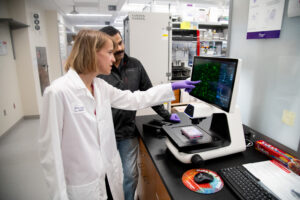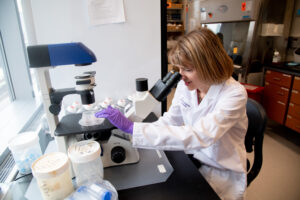Teresa Davoli, PhD ‹ Back To 2024 Winners
2024 Winners
Assistant Professor
Department of Biochemistry and Molecular Pharmacology
NYU Grossman School of Medicine
Vision
More than a century ago Theodore Boveri proposed that ‘abnormal chromosomal constitutions may cause cancer’. Today, we still do not fully understand what the consequences of abnormal chromosomal constitutions are, i.e. aneuploidy in cancer. This is in part due to the lack of methods to accurately model aneuploidy. Last year, my lab contributed to the development of tools that allow engineering chromosomal aneuploidy in human cells. Now, we will use these tools to recapitulate experimentally cancer aneuploidy and to investigate its consequences. We will investigate their effect on cancer phenotypes, interaction with immune cells and synthetic lethalities. Ultimately, we aim at making cancer aneuploidy a tractable target, either by improving current therapies thanks to better biomarkers or by identifying new therapeutic targets that specifically harness vulnerabilities associated with the aneuploid state.
Dr. Davoli obtained her Ph.D. from The Rockefeller University working with Dr. Titia de Lange on the role of telomere dysfunction in tumorigenesis. During her postdoc, she worked with Drs. Stephen Elledge and Peter Park in cancer genetics and genomics. Her lab at NYU Grossman School of Medicine in New York uses experimental and computational approaches to study the causes and consequences of genomic instability in cancer. Her lab found that tumors bearing 9p loss tend to be immune cold and to be refractory to immunotherapy (William et al., PNAS 2021 and Zhao et al. PNAS, 2022). This finding has since been confirmed by others across several tumor types and is having a direct impact on clinical decision-making for cancer patients. Her lab also described a method called KaryoCreate to experimentally engineer specific chromosomal aneuploidies (gains or losses) in human cells which has the potential to foster our understanding of aneuploidy in human cancer and beyond (Bosco et al., Cell 2023). Her long-term goal is to decipher how aneuploidy can be utilized as a biomarker for therapy response and as a target for new cancer treatments that take advantage of synthetic lethality associated with the aneuploid state.
Dr. Davoli received the Weintraub Graduate Student award in 2013 and the Helen Hay Whitney Postdoctoral Fellowship. Dr. Davoli was awarded the Breast Cancer Alliance Young Investigator Award, the V Foundation Scholar Award, a Melanoma Research Association grant, Melanoma Research Alliance Young Investigator Award, the V Foundation Scholar Award and the R37 NIH MERIT Award.
ANlocking ANeuploidy to ANderstand Cancer
 The last 30 years of research have identified more than 500 genes that are mutated (i.e. Defective) in human cancer and a lot of attention has been devoted to these mutations. A central mystery that has not yet been solved is why and how the vast majority of cancers show aneuploidy, i.e. the gain or loss of specific chromosomes (chromosome-specific aneuploidy). For example, tumor cells from colon cancer very often (more than 55% of cases) show in their DNA one extra copy of chromosome 13 (normal cells have 2 copies of chromosome 13, cancer cells have 3/4 copies).
The last 30 years of research have identified more than 500 genes that are mutated (i.e. Defective) in human cancer and a lot of attention has been devoted to these mutations. A central mystery that has not yet been solved is why and how the vast majority of cancers show aneuploidy, i.e. the gain or loss of specific chromosomes (chromosome-specific aneuploidy). For example, tumor cells from colon cancer very often (more than 55% of cases) show in their DNA one extra copy of chromosome 13 (normal cells have 2 copies of chromosome 13, cancer cells have 3/4 copies).
“This Prize will allow us to make important contributions to the field of cancer aneuploidy, in particular in moving the field forward from the era of correlation to the era of causation”

The goal of this proposal is to unravel this mystery and begin to use this information to design new therapeutic strategies. To accomplish this task, we will be taking a novel approach. First, we will use normal human cells and we will engineer them to contain a gain or a loss of a specific chromosome. Then we will utilize a series of experiments to comprehensively characterize the biology of the cells containing the chromosome-specific aneuploidy compared to normal cells. Specifically, we will examine how cells containing chromosome gains or losses interact with immune cells, compared to normal cells. If scientists are able to understand what are the consequences of chromosome-specific aneuploidy for cancer cells compared to normal cells, then we will be able use this insight to develop new, more effective treatments, i.e. therapies that specifically target cancer cells while sparing normal cells.
“Paraphrasing Sidney Brenner, innovation in science and medicine is built upon new technologies, new discoveries and
new cures, likely in that order.”